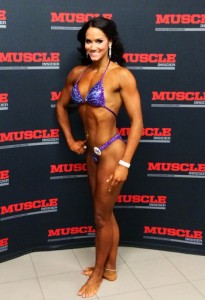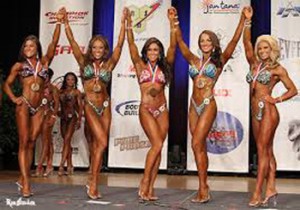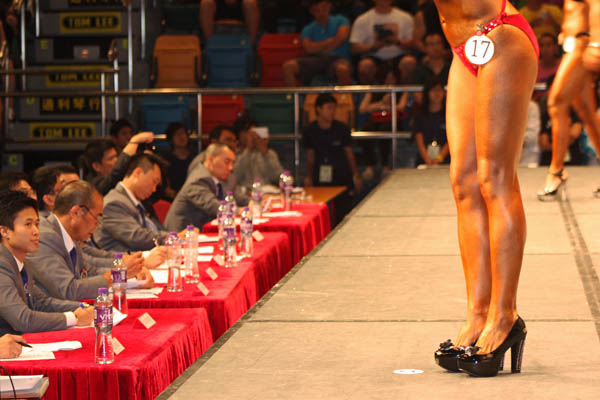Tags
Related Posts
Share This
Strong is the new Skinny: female bodybuilding’s dynamic rise
Cassandra Minors is competing in her first bodybuilding competition. Before hitting the stage at the Ontario Physique Association’s Ottawa Championships—sponsored by health-products giant GNC and held at Algonguin College on Nov. 1, 2014—Cassandra is wandering the theatre’s crowded lobby, chatting with fellow bodybuilding competitors and stopping to check out a few of the fitness-themed merchant booths. The lobby is abuzz with excitement, and filled with both spectators and competitors alike. The female competitors are distinguishable by their sprayed-on russet tans, carefully applied stage makeup, and manicured nails, but, surprisingly, not by their physical size.
Sporting her own deep, fake tan, a smiling Minors is covering her sparkly purple bikini with a black satin bathrobe, blazoned on the back with rhinestones spelling out “Beauty & Beast”. While displaying an impressively defined and muscular physique, Minors doesn’t exactly fit the stereotypically bulky, pumped-up physiques that may come associated with bodybuilding.

Well toned Figure competitor Cassandra Minors at the Ottawa competition in November. [Photo courtesy of Cassandra Minors]
Minors’s experience exemplifies two trends prominent within the female bodybuilding industry today: the inclusion of more competition categories that cater to women with less-muscular physiques than traditional female bodybuilders, and the power of social media to promote this sport and lifestyle. Together, these two factors can be credited with fuelling the explosive rise in popularity that female-bodybuilding contests have experienced over the past decade.
Bikini madness
The International Federation of Bodybuilding and Fitness (IFBB) is the sport’s largest governing body. As one IFBB article stated, “Bodybuilding history accelerates quickly from the beginning of this year: every next event breaks the record of participation!” The 2014 European Championships is cited as just one record-breaking example, with 783 competitors participating. The Bikini division proved the most popular: 189 women out of the 394 females competing did so in the Bikini division.
Bikini is the most recent example of a new category that contradicts the stereotypical image of bulky, masculine women competing in the Bodybuilding division. In 2002, the IFBB implemented the Figure, or “Body-fitness,” division for women who wanted to build less muscle mass and maintain a more feminine silhouette. The IFBB took one step further in 2011 with the addition of the Bikini division, which requires women to build significantly less muscle mass and, according to the IFBB, calls for its competitors’ appearances to be “similar to that of models.”
‘It’s like a beauty pageant with muscles.’ – competitor Cassandra Minors
Meanwhile, the competition organization World Beauty Fitness & Fashion (WBFF) uses different names to categorize its female divisions: Diva Figure Model, Diva Fitness Model and Diva Bikini Model. And it’s strayed even farther from the steroid-enhanced stereotype by adding a new division for 2015, called Commercial Model.
These divisions have one other common factor distinguishing them from the original stereotype: Women aren’t judged solely on their muscle size, but on their hair, makeup, stage presence, symmetry and femininity, as well. “It’s like a beauty pageant with muscles,” explains Minors.
The traditional female bodybuilding division “is slowly phasing out,” explains IFBB Pro Natalie Waples. Ottawa-based Waples is an IFBB professional athlete in both the Figure and Bikini divisions. She competes at an international level, against other pros, since earning her pro status card at the 2008 IFBB North American Figure Championships. She says these new divisions were added because they “appeal to a more attainable and marketable physique.”

IFBB Pro Natalie Waples (second from right) poses with fellow competitors after placing third in the 2011 California Pro.
[Photo ©Ron Avidan]
The social media cycle
As the sport’s popularity grows, so does its social media presence. Competitors are well known for chronicling their journeys on their social media accounts. Instagram was launched in October of 2010, just before the Bikini division was implemented; since then, Instagram has become a space for current and aspiring competitors to interact and follow each other’s preparations, often through a series of fitness-themed hashtags accompanying their photos. One Instagram search of the popular hashtag #Fitspiration yielded over 3.5 million results, while #BikiniCompetitor displayed over 300,000 hits, and 12.8 million posts mentioned #Bodybuilding. Nevertheless, it remains unclear whether social media’s impact is purely positive (see sidebar).
Minors’s bodybuilding campaign started with Instagram, and she says the social media service continues to play a major role in her lifestyle-and-fitness journey as she looks ahead to more competitions. She says posting pictures helps her keep track of her own progress.
Since sending that fateful “Can I come to the gym with you?” Instagram message over a year ago, Minors has lost 40 pounds and placed sixth in her first Figure competition. “So many people are coming to me and asking what I do, how I did it, and how they can do it,” she says. She’s grown used to strangers reaching out to her through social media: telling her that following her Instagram account encourages them to live a healthier life. “I like [posting Instagram photos] because it motivates people,” Minors says. “It’s nice to have people from all across the world say, ‘Wow, you inspire me to do something.’”
The downside of Instagram
Both Natalie Waples and Jamie Bell notice some negative ways that social media has impacted the industry. Waples says that while social media is a vital platform to promote herself as a sponsored athlete, she sees an issue with competitors validating their own importance based on the number of “likes” their posts receive.
Social media can also affect a competitor mentally as she prepares for a show. “Looking at other competitors’ social media accounts would motivate me to push harder on some days,” says former competitor Jamie Bell. “However,” she adds, “on others days it completely psyched me out because I didn’t look like the other girls.” She remembers having a breakdown one month before a show, because some other competitors’ abs were more developed and visible than her own.






